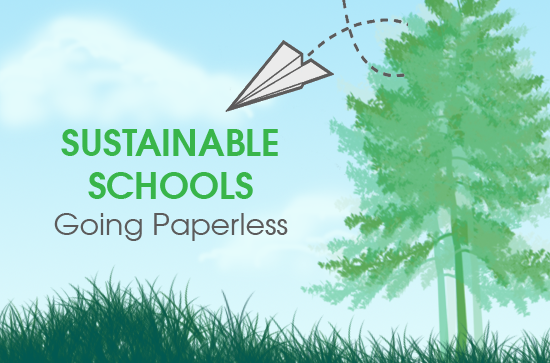(This article was originally posted on blog.fastdir.com)
My friend Erik Lueders is the Sustainability and Purchasing Manager for our local Kirkwood School District. He’s also on the U.S. Green Building Council and participates in local LEED (Leadership for Energy and Environmental Design) projects. So, of course, he’s a wealth of information when it comes to this topic. I asked him for some tips and advice and would love to share what I learned.
Erik has spent several years working with the Kirkwood School District and he loves his job. He helps schools implement change to improve sustainability: mass transit, preserve land, native planting, water efficiency, energy efficiency, recycling, solar power, paper resources, etc. Erik’s work constantly prompts him to ask himself, “how do we change a culture?” He shared with me that the longer anyone does his type of work, the more they realize that inspiring change means helping people come up with action plans and real solutions to problems rather than general goals.
“My experience shows that it’s all about managing people through change. Not what to do, but how to do it. I’ve also found that the faculty needs to be on board and take ownership. If I find a champion or leader in the community, then others will follow.”
Use Your Building as a Teaching Tool
Erik’s inspiring motto, “use your building as a teaching tool” helps remind schools of the importance of setting an example through every aspect of the school, and not just in class. Starting with a very simple part of sustainability, going paperless, we’ve outlined some ideas for change below.
- EASY NOTIFICATIONS: Utilizing email and text notifications for school communications is an important way to ensure contact with your families. Not only does this have an impact on saving paper, but it’s more convenient for families, which improves their ability to receive and actually read school communications. This not only applies to basic school communications or urgent messages, but also billing notices and even fundraising successes. The easier it is to send friendly reminders to families then the easier it will be for them to be involved.
- ONLINE GRADES: Publishing grades (grade books, progress reports, and report cards) online is a very effective way to save paper. Families who cannot access their school information system (information online) could easily request a print out from the office on an individual basis. Parents can also confirm receipt of the information via electronic signature. Schools often print their end of the year reports to satisfy record-keeping requirements, however the rest of the year is a massive opportunity for demonstrating sustainability (use your building as a teaching tool).
- SCHOOL NEWS & CALENDARS: This may seem very basic, but it’s another simple way to save on printing. Posting classroom and school newsletters online is not only green, but a very convenient way to send news home. For those families that do not have internet access, the office can offer printed material to help them, which would still be a large reduction of printing and paper.
- OTHER SCHOOL RESOURCES: Handbooks, reading lists, supply lists, homework information, etc., can easily be uploaded and posted online. For example, a school information system allows users to post documents to the school’s portal for easy downloading. Encourage your school community to seek out help and to ask questions about how to utilize technology for communicating. The more it’s done, the more people will do it – going paperless is contagious!
- CAFETERIA & BILLING: Posting menus online, allowing parents to order lunches online and emailing billing notices to your families is another great way to save paper. It’s about setting expectations. If families are prepared to look for billing information online and can access the information in a convenient place, then there will be no more surprises! As always, there will be a small percent who need printed reminders, but that is a problem with a solution.
- RECYCLING: According to the EPA, “Paper makes up 27 percent of municipal solid waste (MSW), more than any other material Americans throw away. Because of this, recycling paper can greatly reduce the overall amount of MSW produced… Americans recycled about 65 percent of the paper they used in 2012, but more can be done. Recycling reduces greenhouse gas emissions, conserves natural resources, and saves landfill space.” And, the EPA for teachers: “Because paper is a product students use everyday, it provides a great opportunity to discuss paper recycling in the classroom. Learning about and participating in a recycling program is a great way to teach environmental education.”
Where do we start?
(1) Establish your champion, your school sustainability leader and their team of helpers.
(2) Create an action plan of concrete steps and goals (1 ream of paper per teacher per year, utilize school portal for grade reports and newsletters, send billing notices online, etc).
(3) Communicate your plan to the community and answer the question, what’s in it for them? Saving time, saving money, and teaching by example come to mind.
(4) Provide support and resources for your staff. Who should they call for help?
(5) Reap the rewards and see how demonstrating sustainability helps your school community.
CK-12 (a resource for online curriculum content)
Green Schools (the Missouri chapter)
Ecological Footprint Calculator
Center for Green Schools (they work directly with schools to create healthy learning environments)
Green Existing Schools Toolkit
Sustainability Curriculum Resources
Green Classroom Professional (credential for teachers and staff)
Green Education Foundation (free lessons and programs)
Gateway Greening (community gardening and urban agriculture)



